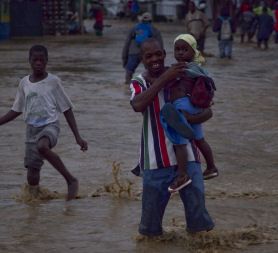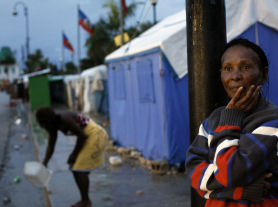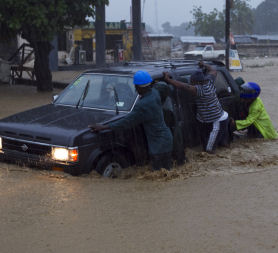Hurricane Tomas strengthens as it sweeps through Haiti
Tropical storm Tomas re-strengthened to a hurricane on Friday and is heading between Cuba and Haiti, which will drench crowded tented camps following the Haitian earthquake.

Some camp dwellers in the Haitian capital Port-au-Prince were able to evacuate to more secure shelter with family, friends and in schools and public buildings. But hundreds of thousands of people had to spend the night under dripping plastic in the muddy encampments.
One resident Zaporte N’Zanou spent the night in the Champs de Mars survivors’ camp outside the presidential palace. He said: “It rained, but it was a normal night and I slept.”
The UN and aid agencies were on high alert as hurricane Tomas approached from the south.

At 8am local time Tomas was moving northeastward towards the west of Haiti, some 160 miles from Port-au-Prince. Sustained winds of 85 miles per hour were recorded by the US National Hurricane Centre.
The storm strengthened over the Caribbean Sea into a category one hurricane on the five step Saffir-Simpson scale, heading on a track that would take it near or over Cuba, the Turks and Caicos Islands as well as the southeastern Bahamas.
The Haitian President Rene Preval addressed the nation on national radio before the storm approached. He urged citizens to take precautions and follow the recommendations to evacuate as the gusting winds and surging waves could lead to severe flooding.
He said: “protect your lives”.
The US National Hurricane Centre said the biggest threat from Tomas was heavy rainfall that could produce flash flooding and mudslides, putting hundreds of thousands of lives at risk.
The January earthquake killed more than a quarter of a million people in Haiti, one of the poorest nations in the world. Some 1.3 million survivors were left living in makeshift camps, cramped in the open spaces of Port-au-Prince.
What impacts upon me immediately is the stoicism of the peoplePoor Haiti writes Channel 4 News Presenter Jon Snow. Spawned by imperialists, reduced by earthquake, sickened by cholera, and now "le deluge".
What impacts upon me immediately is the stoicism of the people - good natured, accepting of their awful fate and probable destiny. I was here two days after the earthquake hit in January. Since that time the urban sprawls of tented encampments have consolidated into canvas, timber, and corrugated tin homes. The density is absolute - ten to a shack, families are crammed everywhere.
Wandering through one camp of the Internally Displaced Persons (IDPs) we came upon an intense football game - of great skill and of huge concentration for those ten boys playing. A boy was being towed along in a wheelie case by another. Everywhere there are tableaux of defiance, of turning whatever little there is to remarkably imaginative good use.

Three emergencies at once
Less than a month before 28 November presidential and legislative elections, Haiti faces three major emergencies at once, with the hurricane, the quake rebuilding and a cholera outbreak which has killed at least 442 people.
All camps have a committee charged with keeping order and several leaders have been trying to alleviate conditions for the most vulnerable.
Yves-Marie Sopin who is at a camp holding 5,000 people said: “We are putting old people and young families in the Red Cross shelter.”
Ave Lise Mesila said: “We haven’t taken precautions. We are in God’s hands.”
The UN has warned that the storm will almost certainly exacerbate the cholera epidemic, which has also made over 6,700 people ill.
Leonard Doyle, spokesman for the International Organisation for Migration said: “The big fear is for people on exposed mountains. These people are at high risk of landslides and flash flooding.”
Tomas has already killed five people in St Lucia over the weekend, with several more people missing.
Haitian schools were closed on Thursday and Friday. Schools were also closed in parts of Jamaica, where Tropical Storm Nicole killed 15 people more than a month ago.